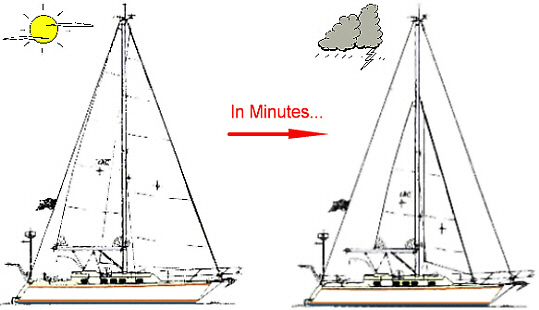| QUESTION: Why is the Caliber Convertible Cutter Rig™ considered a safety feature? | |
| ANSWER: While cruising, if heavy weather is encountered, the Sloop Rig can instantly be converted into a heavy air rig that is self tacking. This can be done in a matter of minutes! Creating a well balanced and totally inboard rig that is strongly supported. | |
|
Caliber Convertible Cutter Rig™ |
|
|
|
|
| Convenient Sloop Rig | Heavy Weather Cutter Rig |
| Sail plan that is efficient and easily tacked for light to moderate winds. | Sail plan is strong, perfect balance, self-tacking for heavy to storm winds. |
| From “Modern Cruising Under Sail” by Don Dodds | |
| “The advantages of the cutter rig for boats between 35 and 45 feet are being recognized by the cruising community. In a recent survey, 48 percent named the cutter as their preferred rig. Also, 19 percent of the sloop owners would abandon that rig in favor of the more flexible cutter. But, more surprisingly, 10 percent of the ketch owners would opt for the more efficient cutter rig. (Jimmy Cornell, World Cruising Survey).”” | |
| From “Readers Design the Ideal Bluewater Cruiser” by Quentin Warren for Cruising World Magazine | |
| “The cutter rig is desired by the majority and makes good sense for offshore use. A quick release lever on the forestay would convert her into a handier sloop when tacking in tight coastal waters.” | |
| From “Singlehanded Sailing: The Experiences and Techniques of the Lone Voyagers” by Richard Henderson | |
|
“There are
many advantages to the cutter rig for general-purpose singlehanding. The
cutter provides a three-sail rig for easy management, but with only one
mast. Sail is more centralized or concentrated amidships as compared with
other rigs. This increases safety, because there is a wide working space
with minimal motion near the mast, and the crew seldom has to venture onto
the boat's extremities in heavy weather. Also, the mast amidships provides a
wide base for efficient staying, while its weight in that location has a
favorable effect on the moment of inertia to help alleviate extreme
pitching. [...] In contrast [to a ketch rig], the cutter can reduce sail quite effectively and safely by dropping or rolling up her jib, and the staysail with a slightly reefed main usually provides an efficient rig for prolonged windward sailing in a blow.” |
|
